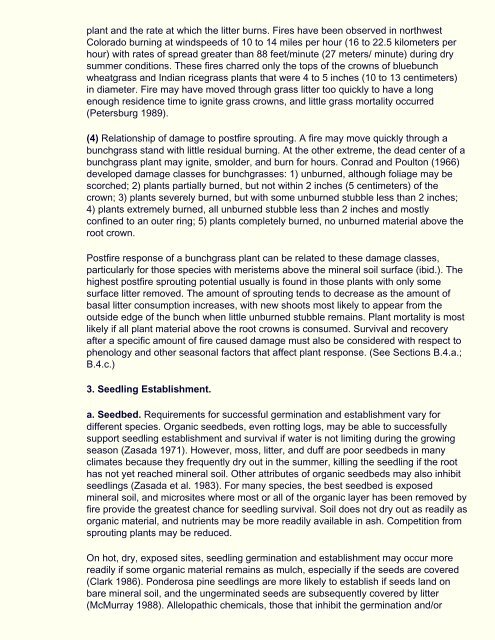FIRE EFFECTS GUIDE - National Wildfire Coordinating Group
FIRE EFFECTS GUIDE - National Wildfire Coordinating Group
FIRE EFFECTS GUIDE - National Wildfire Coordinating Group
Create successful ePaper yourself
Turn your PDF publications into a flip-book with our unique Google optimized e-Paper software.
plant and the rate at which the litter burns. Fires have been observed in northwest<br />
Colorado burning at windspeeds of 10 to 14 miles per hour (16 to 22.5 kilometers per<br />
hour) with rates of spread greater than 88 feet/minute (27 meters/ minute) during dry<br />
summer conditions. These fires charred only the tops of the crowns of bluebunch<br />
wheatgrass and Indian ricegrass plants that were 4 to 5 inches (10 to 13 centimeters)<br />
in diameter. Fire may have moved through grass litter too quickly to have a long<br />
enough residence time to ignite grass crowns, and little grass mortality occurred<br />
(Petersburg 1989).<br />
(4) Relationship of damage to postfire sprouting. A fire may move quickly through a<br />
bunchgrass stand with little residual burning. At the other extreme, the dead center of a<br />
bunchgrass plant may ignite, smolder, and burn for hours. Conrad and Poulton (1966)<br />
developed damage classes for bunchgrasses: 1) unburned, although foliage may be<br />
scorched; 2) plants partially burned, but not within 2 inches (5 centimeters) of the<br />
crown; 3) plants severely burned, but with some unburned stubble less than 2 inches;<br />
4) plants extremely burned, all unburned stubble less than 2 inches and mostly<br />
confined to an outer ring; 5) plants completely burned, no unburned material above the<br />
root crown.<br />
Postfire response of a bunchgrass plant can be related to these damage classes,<br />
particularly for those species with meristems above the mineral soil surface (ibid.). The<br />
highest postfire sprouting potential usually is found in those plants with only some<br />
surface litter removed. The amount of sprouting tends to decrease as the amount of<br />
basal litter consumption increases, with new shoots most likely to appear from the<br />
outside edge of the bunch when little unburned stubble remains. Plant mortality is most<br />
likely if all plant material above the root crowns is consumed. Survival and recovery<br />
after a specific amount of fire caused damage must also be considered with respect to<br />
phenology and other seasonal factors that affect plant response. (See Sections B.4.a.;<br />
B.4.c.)<br />
3. Seedling Establishment.<br />
a. Seedbed. Requirements for successful germination and establishment vary for<br />
different species. Organic seedbeds, even rotting logs, may be able to successfully<br />
support seedling establishment and survival if water is not limiting during the growing<br />
season (Zasada 1971). However, moss, litter, and duff are poor seedbeds in many<br />
climates because they frequently dry out in the summer, killing the seedling if the root<br />
has not yet reached mineral soil. Other attributes of organic seedbeds may also inhibit<br />
seedlings (Zasada et al. 1983). For many species, the best seedbed is exposed<br />
mineral soil, and microsites where most or all of the organic layer has been removed by<br />
fire provide the greatest chance for seedling survival. Soil does not dry out as readily as<br />
organic material, and nutrients may be more readily available in ash. Competition from<br />
sprouting plants may be reduced.<br />
On hot, dry, exposed sites, seedling germination and establishment may occur more<br />
readily if some organic material remains as mulch, especially if the seeds are covered<br />
(Clark 1986). Ponderosa pine seedlings are more likely to establish if seeds land on<br />
bare mineral soil, and the ungerminated seeds are subsequently covered by litter<br />
(McMurray 1988). Allelopathic chemicals, those that inhibit the germination and/or
















